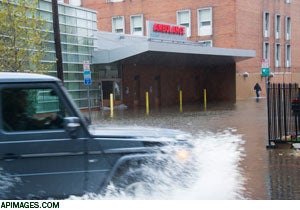Sandy renews need to assess emergency power systems
 The impact of Hurricane Sandy has renewed the importance and challenge of hospitals being prepared for catastrophic weather after the super storm hammered the Northeast in October.
The impact of Hurricane Sandy has renewed the importance and challenge of hospitals being prepared for catastrophic weather after the super storm hammered the Northeast in October.
Thankfully, except for a couple of hospitals whose emergency power supply systems (EPSS) failed and resulted in patient evacuations, emergency backup systems at most hospitals in the region worked with no or minimal disruption.
The challenge of preparing for an extreme weather emergency was evident in the case of New York University (NYU) Langone Medical Center, New York City. When utility service was lost and the EPSS failed during Sandy because of severe flooding, heroic staff evacuated more than 200 patients, including premature babies, by flashlight.
Christopher Rucas, director of media relations, NYU Langone, says the health care facility's EPSS was designed and built according to all safety codes. "We believed we could withstand a surge of approximately 12 feet, which is above the 100-year flood level for New York City," Rucas says.
"Even though our facility and our faculty and staff were trained and prepared for the storm, this was an unprecedented event," he says.
The surge from Hurricane Sandy was recorded at 13.88 feet at Battery Park, which was 2.68 feet higher than the record level in 1821. "In our location, we believe the surge from Sandy may have been even higher," he says.
This shows that even with abundant planning there's no perfect EPSS that is guaranteed to sustain the impact of Mother Nature's fury. But there are steps facilities can take to minimize the risk of EPSS failure, experts say.
David Stymiest, senior consultant, Smith Seckman Reid Inc., Nashville, Tenn., recommends conducting a vulnerability analysis for starters.
"Once you've assessed what vulnerabilities there are, then come up with a plan to deal with them," he says. He adds that his opinions on the issue are his only and not that of the National Fire Protection Association (NFPA), for which he serves as chairman of the Technical Committee on Emergency Power Supplies responsible for NFPA 110 and 111.
The importance of conducting a vulnerability assessment is noted in the Joint Commission "Sentinel Event Alert, Issue 37," which was published in 2006 and offers guidance on how to reduce risk of EPSS failure. The alert states that NFPA has codes establishing minimum design, installation and testing of EPSS systems, but they may not be enough.
"To assure optimal safety during catastrophes, health care organizations are encouraged to go beyond the minimum NFPA life safety requirements and to conduct thorough vulnerability analyses of their facilities," the alert states.
Dan Chisholm Sr., president, MGI Consulting Inc., Winter Park, Fla., and Sedona, Ariz., spoke to a group of about 40 hospital directors of engineering at an American Society for Healthcare Engineering chapter meeting in Union, N.J., to discuss how their facilities weathered the storm. Engineers said their EPSS worked well overall and their biggest concern was running out of fuel and not getting deliveries, Chisholm says.
He emphasizes the importance of system redundancy as prevention against EPSS failures. "For an EPSS to be totally bulletproof, for it to function properly if the utility is knocked out, there needs to be redundant components within that EPSS," he says.
Stymiest has advice on how to design an EPSS at a new hospital. "I would want to put generators above the expected flood stage. I would want to put the generator subsystems — the starting, fuel and cooling systems — above the flood stage.
"I would want to make sure the subsystems are protected from wind-borne hazards," he says. "I would want to do the same thing with the distribution system that the generator feeds as well as controls."
Access Sentinel Event Alert, Issue 37.




